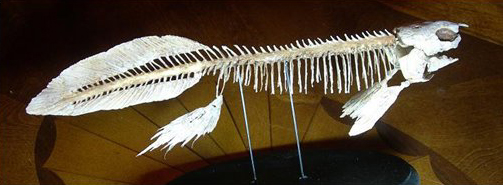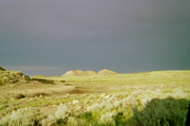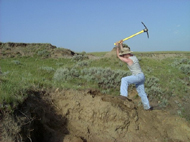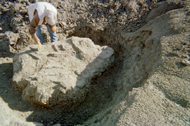Department of Paleontology: Research 2
Permiam Lagersatte

Gnathorhiza
In the hills of Kansas exists an ancient fossilized seasonal pond from the Permian period, approximately 280 million years old. At a time before dinosaurs, mammals, or birds even existed, the Permian ecosystem was quite an alien place. The first firm foothold of land animals occurred in the Permian, an extension of the critical transition from water vertebrates – fish and amphibians – to terrestrial creatures. Unfortunately, North American Lower Permian sites are not as common as scientists would like and Permian sites in Kansas that contain vertebrate remains are exceedingly rare. The Permian research site, examined by both University of Kansas and Palm Beach Museum personnel, contains a dense assemblage of primitive lobe-finned fish such as the lungfish Gnathorhiza and osteolepiform fish, and amphibians such as lysorophids and labyrinthodonts. Perhaps two new species exist at the site and even more may be discovered in the future. Some projects centering on the Permian locality are as follows:
Reconstruction of the lungfish Gnathorhiza
Reconstruction of the labyrinthodont Acroplous
Reconstruction of the Lysorophid
Although fossil lungfish have been documented before, very few three dimensional reconstructions have been made. Fossil material from the Permian locality have been painstakingly prepared, stabilized, molded, and used to produce the first complete, three dimensional Gnathorhiza skeletal reconstruction.
In a similar fashion to the lungfish reconstruction, exceptionally well preserved remains of the primitive amphibian Acroplous were prepared and the first complete, three dimensional reconstruction of the creature is currently underway.
RBones of a lysorophid amphibian, a long ribbon-like creature, were uncovered at the Permian locality and the bones are currently being prepared and restored so that a three dimensional reconstruction can be fabricated.
Burrowing labyrinthodonts
New species of transitional amphibian
Detailed paleoecological reconstruction
Although suspected for some time, it was never demonstrated that the labyrinthodont Acroplous produced burrows. Robert’s discovery of a complete skeleton preserved within a fossilized burrow provides compelling evidence for the first time that Acroplous did, indeed, produce burrows.
While studying the vertebrate remains at the Permian locality, Robert discovered what appeared to be a combination of a labyrinthodont amphibian and a fish. The creature, whose body resembled a typical labyrinthodont in most respects, had scales resembling those of a lungfish and fins instead of arms and legs. The creature, representing a transitional form between aquatic and terrestrial organisms, is new to science and is currently being investigated.
The Permian locality contains a plethora of vertebrate and geological clues needed to reconstruct the paleoecology and depositional history of the site. Over time, a detailed study shall piece together the site’s depositional history and elucidate the climate of the Lower Permian.
Pennsylvanian marine/nearshore deposits
Like the Permian, the older Pennsylvanian period was an age ruled by primitive creatures, giant insects, and alien flora. Club mosses grew to the size of trees, dragonflies had bodies the size of baseball bats, and reptiles were getting their first foothold on the planet. Pennsylvanian research areas include localities rich in marine organisms such as brachiopods, bryozoans, trilobites, and crinoids, as well as remains of terrestrial life such as insects, plants, and vertebrates. Research of the Pennsylvanian material will shed light on climatic conditions 300 million years ago and explore the interactions between different organisms of the time. Some research topics are as follows:
Pennsylvanian plant assemblages
Brachiopods, bryozoans, crinoids, trilobites, and
invertebrates of the inland sea
Vertebrate remains from nearshore estuaries
Vertebrate trackways created by reptilian ancestors to mammals
Invertebrate burrows in the marine setting



